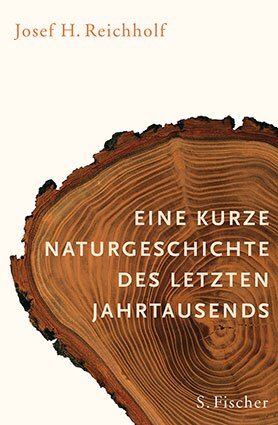Josef H. Reichholf
Eine kurze Naturgeschichte des letzten Jahrtausends
[A short natural history of the last Millennium]
- S. Fischer Verlag
- Frankfurt am Main 2007
- ISBN 978-3-10-062942-5
- 336 Pages
- Publisher’s contact details
Josef H. Reichholf
Eine kurze Naturgeschichte des letzten Jahrtausends
[A short natural history of the last Millennium]
Published in Portugiesisch (Bras.) with a grant from Litrix.de.
Sample translations
Review
“Combining human history and natural history is too great a task for one individual to be able to master. But that doesn’t render it unnecessary.”
Josef H. Reichholf is an evolutionary biologist. In addition, he is professor of nature conservation at the Technical University of Munich, chief conservator and director of the Vertebrate Section of the Bavarian State Collection of Zoology and sits on the board of WWF Germany. Along the way he has also written roughly half a dozen books on a wide range of topics in evolutionary biology. Despite the reservations quoted above, he set out to establish a relationship between the history of mankind and the history of climate change, which he has now accomplished in this tremendously exciting book. Far from explaining historical events solely on the basis of climatic conditions, as the occasional critic has decried, his intention is to show to what extent changes in climatic conditions have influenced human societies (and will continue to do so).
However, the author prefaces his examination of the last thousand years of European history with another review reaching back to the last ice age. This allows him to illustrate the time spans in which climatic developments must be examined. As a result it becomes clear that a period of 1,000 years is extremely short in geological and climatic terms and represents nothing but the last phase of fluctuating developments that are difficult to predict.
The review begins with the late phase of the last ice age some 30,000 years ago, when modern humans (Homo sapiens) reached Europe where they lived as hunters and gatherers. As the ice age drew to close c. 10,000 years ago, climatic conditions gradually began to change, sea levels rose and temperatures became increasingly moderate. This allowed agriculture and animal husbandry to arise; the first permanent settlements and cultic buildings came into existence.
Yet even during the warm stage (the “Holocene”) that still prevails today there were colder and warmer periods, and it is hardly coincidental that they ran parallel to major historical transitions. For example, the Roman Empire rose and flourished during a warm period, whereas the great European migrations occurred during the 4th to 6th centuries A.D. when Northeastern Europe was considerably colder. At the beginning of the Middle Ages, just before the turn of the millennium, the climate turned warm again offering favorable conditions for human beings to develop and multiply. Reichholf’s detailed examination begins at this point in time.
In Reichholf’s view, one of the primary indications for a close connection between natural and human history is the robust population growth that takes place under favorable climatic conditions and is followed by various, often aggressive forms of expansion. As examples he cites the forays and discovery expeditions of the Vikings, the Christian Crusades and the Mongolian campaigns of conquest. All of these undertakings could only become realities because societies had a large surplus of young people who would be unable to inherit any land and therefore constituted a threat to social stability. They were therefore dispatched on honorable missions from which only a small number returned. The author repeatedly emphasizes that this must not be interpreted as a systematic, intentional “disposal strategy” on the part of those in power, but only emerges as such from the perspective of historical distance. The author’s intention is to include climate in the discussion as an important additional factor.
Reichholf also cites copious evidence for his theory from the centuries spanning the late Middle Ages and the beginning of the Modern Age. During the phase of the so-called “Little Ice Age” which produced difficult living conditions in central Europe between the 15th and 18th centuries, political and military power and, concurrently, economic prosperity shifted to the warmer southwestern region, namely, the Iberian Peninsula. Meanwhile, devastating wars broke out in the center of Europe, leaving the population decimated through war, natural catastrophes and epidemics. In the 19th century a new warm stage began which gave rise to a concept of nature in Central Europe that many people view as ideal to this day. The tamed, Central European park landscape was simultaneously presented as the counterpart to industrialized cities and became a favored subject of poets and painters. In the process one often forgets that the landscape resulted from the interaction climatic conditions, intensive agricultural utilization and shaping by human beings. From the perspective of natural history this view of nature is based on no more than a historical snapshot of Central Europe.
In light of the current discussion about the connection between CO2 emissions and climate warming, Reichholf directs the reader’s attention to developments that in his estimation pose far greater dangers to climatic equilibrium. In addition to the large scale slashing and burning of tropical forests to clear fields for the cultivation fodder crops, he views the constant over-fertilization of agricultural soil and the contamination of groundwater supplies as key damage factors for climate and environment. This book is an attempt to establish the current climate debate on the basis of fact, without trivializing the dangers. In part, the author directs his criticism against self-proclaimed prophets with a kind of Central European sense of mission. They would like to see their ideas about nature realized on a global scale, yet their concept of nature is static. Reichholf equally criticizes the lifestyle of the West, where massive consumption of goods and services has become the ultimate goal. It remains an unanswered question whether human beings will be capable of rational action over the long term as a species or whether only a small minority will assert their will. For Reichholf entertains not even the slightest doubt that mankind will also have the capacity to adjust to change in the future.

Josef H. Reichholf is an evolutionary biologist. In addition, he is professor of nature conservation at the Technical University of Munich, chief conservator and director of the Vertebrate Section of the Bavarian State Collection of Zoology and sits on the board of WWF Germany. Along the way he has also written roughly half a dozen books on a wide range of topics in evolutionary biology. Despite the reservations quoted above, he set out to establish a relationship between the history of mankind and the history of climate change, which he has now accomplished in this tremendously exciting book. Far from explaining historical events solely on the basis of climatic conditions, as the occasional critic has decried, his intention is to show to what extent changes in climatic conditions have influenced human societies (and will continue to do so).
However, the author prefaces his examination of the last thousand years of European history with another review reaching back to the last ice age. This allows him to illustrate the time spans in which climatic developments must be examined. As a result it becomes clear that a period of 1,000 years is extremely short in geological and climatic terms and represents nothing but the last phase of fluctuating developments that are difficult to predict.
The review begins with the late phase of the last ice age some 30,000 years ago, when modern humans (Homo sapiens) reached Europe where they lived as hunters and gatherers. As the ice age drew to close c. 10,000 years ago, climatic conditions gradually began to change, sea levels rose and temperatures became increasingly moderate. This allowed agriculture and animal husbandry to arise; the first permanent settlements and cultic buildings came into existence.
Yet even during the warm stage (the “Holocene”) that still prevails today there were colder and warmer periods, and it is hardly coincidental that they ran parallel to major historical transitions. For example, the Roman Empire rose and flourished during a warm period, whereas the great European migrations occurred during the 4th to 6th centuries A.D. when Northeastern Europe was considerably colder. At the beginning of the Middle Ages, just before the turn of the millennium, the climate turned warm again offering favorable conditions for human beings to develop and multiply. Reichholf’s detailed examination begins at this point in time.
In Reichholf’s view, one of the primary indications for a close connection between natural and human history is the robust population growth that takes place under favorable climatic conditions and is followed by various, often aggressive forms of expansion. As examples he cites the forays and discovery expeditions of the Vikings, the Christian Crusades and the Mongolian campaigns of conquest. All of these undertakings could only become realities because societies had a large surplus of young people who would be unable to inherit any land and therefore constituted a threat to social stability. They were therefore dispatched on honorable missions from which only a small number returned. The author repeatedly emphasizes that this must not be interpreted as a systematic, intentional “disposal strategy” on the part of those in power, but only emerges as such from the perspective of historical distance. The author’s intention is to include climate in the discussion as an important additional factor.
Reichholf also cites copious evidence for his theory from the centuries spanning the late Middle Ages and the beginning of the Modern Age. During the phase of the so-called “Little Ice Age” which produced difficult living conditions in central Europe between the 15th and 18th centuries, political and military power and, concurrently, economic prosperity shifted to the warmer southwestern region, namely, the Iberian Peninsula. Meanwhile, devastating wars broke out in the center of Europe, leaving the population decimated through war, natural catastrophes and epidemics. In the 19th century a new warm stage began which gave rise to a concept of nature in Central Europe that many people view as ideal to this day. The tamed, Central European park landscape was simultaneously presented as the counterpart to industrialized cities and became a favored subject of poets and painters. In the process one often forgets that the landscape resulted from the interaction climatic conditions, intensive agricultural utilization and shaping by human beings. From the perspective of natural history this view of nature is based on no more than a historical snapshot of Central Europe.
In light of the current discussion about the connection between CO2 emissions and climate warming, Reichholf directs the reader’s attention to developments that in his estimation pose far greater dangers to climatic equilibrium. In addition to the large scale slashing and burning of tropical forests to clear fields for the cultivation fodder crops, he views the constant over-fertilization of agricultural soil and the contamination of groundwater supplies as key damage factors for climate and environment. This book is an attempt to establish the current climate debate on the basis of fact, without trivializing the dangers. In part, the author directs his criticism against self-proclaimed prophets with a kind of Central European sense of mission. They would like to see their ideas about nature realized on a global scale, yet their concept of nature is static. Reichholf equally criticizes the lifestyle of the West, where massive consumption of goods and services has become the ultimate goal. It remains an unanswered question whether human beings will be capable of rational action over the long term as a species or whether only a small minority will assert their will. For Reichholf entertains not even the slightest doubt that mankind will also have the capacity to adjust to change in the future.
Translated by Philip Schmitz

By Heike Friesel
